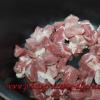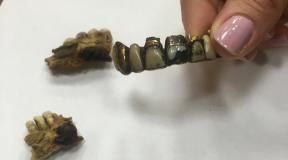Botulism - what is it? Pathogen, symptoms and treatment. Botulism. Causes, symptoms and forms Who causes botulism
Botulism is one of the most severe, acute, saprozoonotic bacterial toxic infections, with a fecal-oral transmission mechanism, characterized by damage to the central and autonomic nervous system, with the occurrence of paresis and paralysis of striated and smooth muscles.
The name comes from the Latin word botulus - sausage, because the pathogen was discovered there, and it was also in the bodies of deceased people who consumed it. The occurrence of this disease is still associated with eating salted or smoked fish, as well as ham.
The causative agent of botulism
The causative agent is Clostridium botulinum, it is a rod with flagella along the periphery, therefore it is called peritrichous - they provide mobility. The structure of the pathogen has a small number of features that predetermine symptoms:
Botulinum toxin is the most powerful exotoxin (even in comparison with tetanus), i.e. a biologically active substance that is always released from the pathogen. There are several types of this toxin - proteolytic and non-proteolytic, that is, they are divided according to their ability to ferment substances for self-activation and production of H₂S. People are most susceptible to 7 types of toxins (A, B, C, D, E, F, G) - but these are all variations of the same botulinum toxin, but the specificity and lethality are determined by various functional components, such as the presence of a neurotoxin and the ability to hemagglutination.
The peculiarity of botulinum toxin activation is under the influence of proteolytic enzymes (either their own or in the gastrointestinal tract), as a result of which the neurotoxin (botulinum toxin) is divided into 2 chains: the H-chain ensures the attachment of the toxin to the cell membrane receptor, due to binding to the synoptic membrane of neuromuscular cholinergic synapses (connections) innervating striated and smooth muscles. The L-chain has a blocking effect on cholinergic transmission by cleaving specific synaptic proteins (SNAP-25 and synaptobrevin - similar to tetanus), the connection of synoptic vesicles with the presynaptic membrane is disrupted, and blockage of the passage of the nerve impulse occurs with normal production of acetylcholine and cholinesterase.
Toxin types B, C, D, F are also dangerous, because they can activate their own neurotoxin with their own enzymes without entering the gastrointestinal tract. In this case, not only is the incubation period shortened, but symptoms also appear even when the contaminated product was in the mouth but was not swallowed.
Specific activity:
- Leukotoxic (suppression of phagocytosis without damaging leukocytes, i.e. phagocytic cells),
- Hemolytic (destroys red blood cells);
- Leukocyte (breaks down phospholipids of the cell membrane).
The pathogen can be in two forms - vegetative (indicated by the yellow arrow in the figure below) and spore (blue arrow) - this is important for preventive measures, because vegetative forms are the most pathogenic and are not resistant to harmful factors. The spore form is the ability to form spores, that is, the emergence of almost unshakable resistance. The spore is formed terminally, that is, almost at the end, the pathogen takes the form of a “tennis racket.”
Stability:
1. The spore form - at a temperature of 6°C - persists for several months, at 100° - 1-2 hours, at 120° - dies within 30 minutes, but some strains can survive for several hours at this temperature. The spores are resistant to freezing and drying, even to direct UV radiation. When dried, they last for decades. The effect of disinfectant solutions is activated within a few hours: a 20% formalin solution kills the pathogen within 24 hours; ethyl alcohol for 2 months; 10% hydrochloric acid solution - after an hour.
2. The vegetative form is not very stable in the external environment and, at 80°C, dies within 30 minutes.
3. The toxin is destroyed at the same temperature as the vegetative form: 100°-10 minutes, well neutralized in alkali, but resistant to acid. In the gastrointestinal tract it reduces its activity, except for type E, which, on the contrary, increases its activity 10,000 times.
Botulism occurs in all regions, but is more often recorded in countries where the population consumes a large number of different canned foods (both plant and animal content); we can say that there are no territorial restrictions. All people are highly sensitive to the toxin, without restrictions on gender or age. Seasonality is also not noted.
Features of using botulinum toxin in everyday life:
1. As a biological weapon, by obtaining a pure toxin, where 1g = 1 million lethal doses, i.e. it can be used as a means of mass destruction.
2. As a drug for the treatment of muscle contractures in cosmetology (“Botex”)
Causes of infection with chatulism
The natural habitat and, as a result, the source is soil, therefore the pathogen is called saprozoonosis. Also the source is water, dust, food products contaminated with soil, intestinal contents of fish and birds, honey - but in these habitats, the pathogen is often in spore form and turns into vegetative when favorable conditions are created: t° = 28-35 ° C, anaerobic = oxygen-free conditions (canned food), activation by proteolytic enzymes in the gastrointestinal tract. Infection most often occurs in vegetative forms; infection with spores is possible only in two cases - with wound infection and with botulism in newborns. Ways – food and contact-household.
Symptoms of botulism
The incubation period is considered from the moment of introduction of the pathogen to the first clinical manifestations. It lasts up to a day, but can vary from 2-12 days, which is extremely rare and only happens with wound botulism and neonatal botulism. Penetrating through the gastrointestinal tract, the pathogen activates lecithinase and leukopenic activity (more details in the description of the pathogen) - they facilitate the penetration of the pathogen into the underlying tissues with parallel protection from phagocytosis. At the stages of implementation, the toxin begins to act due to activation by proteolytic enzymes of the gastrointestinal tract and, as soon as the toxin is activated, symptoms appear.

The period of clinical manifestations begins acutely and lasts for 3 weeks, with a gradual decrease in clinical symptoms. This period is characterized by the following:
Acute sudden onset in the form of general clinical symptoms (headache, dizziness, possible rise in body temperature to 38°C)
Symptoms of gastroenteritis in 90% of cases appear in the first place during the first day from the moment of consumption of the contaminated product, manifested by cramping pain in the epigastric area (approximately in the stomach area), vomiting, and diarrhea.
Within a few hours, neurological symptoms appear in the form of various combinations of myoneurological syndromes:
- ophthalmoplegic syndrome;
- bulbar syndrome in the form of paresis of the pharyngoglossal muscles with damage to the IX (glossopharyngeal), X (vagus), XII (hypoglossal) pairs of cranial nerves;
- damage to the parasympathetic system and changes in the cardiovascular system;
Explains neurological symptoms
- tropism (selective damage) to neurons of the medulla oblongata and motor neurons of the spinal cord;
- the peculiarity of the action of the toxin is that it increases the permeability of the affected tissues;
- First of all, muscles with high functional activity are affected, those that are in constant tension/movement (oculomotor, pharyngeal muscles, etc.)
It happens that there may be no symptoms of gastroenteritis, and the first manifestations are neurological symptoms.
Ophthalmoplegic syndrome:
- grid or fog before the eyes;
- inability to read and see nearby objects, but maintaining good foresight - this is explained by paresis of the ciliary muscles, those that change the configuration of the lens, as a result of their damage, the lens is in a constant relaxed state, which happens when concentrating on distant objects;
- strabismus (strobism);
- double vision (diplopia);
- drooping eyelids (ptosis);
- dilated pupils that do not respond to light (mydriasis);
- uneven pupils (anisocoria);
- nystagmus (involuntary movements of the eyeballs);
- in severe cases, immobility of the eyeballs may occur.
Bulbar syndrome is manifested by aphonia and dysphagia. Aphonia: slurred speech, with a nasal tint, paresis of the muscles of the tongue, hoarseness of voice. Dysphagia is caused by paresis of the muscles of the pharynx, epiglottis and soft palate, which results in: impaired swallowing of both solid and liquid food, the latter flows out through the nose, and choking is also noted when trying to swallow even saliva.
Bilateral paresis of the facial nerve is manifested by a “mask-like face” due to a violation of the facial muscles.
Paresis of the diaphragm and auxiliary respiratory muscles:
- limited mobility of the pulmonary edge occurs due to paralysis of the intercostal muscles, patients complain of a feeling of compression of the chest “as if by a hoop”;
- interruption of speech due to a feeling of lack of air;
- tachypneous (respiratory rates) and shallow breathing;
- respiratory failure can increase either gradually or suddenly - a sudden cessation of breathing occurs (apnea) and “death occurs immediately”;
- Bulbar syndrome contributes to the formation of respiratory failure.
Damage to the parasympathetic nervous system:
- dry skin and mucous membranes;
- decreased salivation;
- disruption of the innervation of the gastrointestinal tract up to the development of paralytic intestinal obstruction;
- urodynamic disturbance in the form of acute urinary retention or involuntary urination.
Changes in the cardiovascular system:
- bradycardia (decreased heart rate) alternates with tachycardia (increased heart rate);
- tendency to increase blood pressure;
- disturbance of the conduction of excitation, with the occurrence of atrioventricular block (AV block);
- increasing shortness of breath.
As the disease progresses, muscle weakness increases, at first it is most pronounced in the occipital muscles and therefore the head can hang, patients try to hold it. Muscle asthenia can persist for up to 6 months.
Hypoxia (↓O₂ in peripheral blood) of various origins is important in aggravating symptoms:
- respiratory (due to paresis of the diaphragm and auxiliary respiratory muscles);
- toxic (direct and indirect effect of the toxin through inhibition of the enzymes of the pentose phosphate shunt and K-Na pump);
- circulatory (due to hemodynamic disturbances)
The duration of the disease is on average 3 weeks, provided that treatment is carried out. Neurological symptoms are restored in the reverse order: first breathing, and then swallowing. The remaining manifestations - headache, nasal tone, ophthalmoplegic, parasympathetic and other neurological symptoms - pass without a specific sequence and can persist for a long time (up to 1.5 months or more). In those who have recovered from the disease, all symptoms disappear without a trace and do not leave any disabling consequences. Without treatment, the most likely outcome is death.
The effect of botulinum toxin on the body.

Features of wound and infant botulism:
- Long incubation period;
- Infection is not vegetative, but spore-forming forms;
- No gastrointestinal period;
- Neonatal botulism manifests itself in the form of lethargy, weakness or refusal to suck, stool retention, ophthalmoplegic symptoms, hoarse crying, weakened swallowing or sucking reflex;
- In children, complications such as pneumonia occur more frequently and deaths are more common.
Diagnosis of botulism
1. According to epidemic data - consumption of home-made canned food.
2. According to clinical data - localization and symmetry of damage to the nervous system, absence of febrile / intoxication / cerebral and meningeal syndromes.
3. Laboratory diagnostics: aimed at detecting the pathogen in food products and biomaterials of the patient (blood, washing water, feces and urine), using RN (neutralization reactions) and ELISA (enzyme-linked immunosorbent assay) - these results can be ready within 8 hours.
The causative agent of botulism under a microscope (spores)
4. Determination of the level of cardiac-specific enzymes to determine the degree of compensation from the heart and blood vessels: MB-creatine phosphokinase, aspartic transaminase, hydroxybutyrate dehydrogenase, tropanine. For this, an additional ECG is performed.
Treatment of botulism
1. Antitoxic anti-botulinum horse serum mono/or polyvalent (in the case of an unknown type of botulinum toxin) or human anti-botulinum immunoglobulin.
2. Prednisolone is administered in parallel with a therapeutic dose of serum to avoid anaphylactic shock. For the same reasons, before introducing the serum, a test is carried out in small doses and, if an allergic reaction is observed, the dose of prednesone is increased.
3. Due to paresis of the pharyngo-lingual muscles, there is a high risk of aspiration (blockage of the respiratory tract), and due to paresis of the diaphragm and respiratory muscles, respiratory failure is formed - as a result of these two life-threatening factors, patients are transferred to tube and parenteral nutrition, and also connected to the ventilator.
4. In case of myocardial damage, cytoprotectors are prescribed.
5. For bacterial complications, broad-spectrum antibiotics are prescribed.
6. In the early stages, the pathogen is also affected through the gastrointestinal tract, by gastric lavage and cleansing enemas, and sorbents are also prescribed.
Nutrition during and after illness
Therapeutic nutrition involves the exclusion of dishes rich in extractive substances, spices and fatty foods. They also prescribe diet No. 10. It is preferable to switch to mixtures with high energy activity. Bed rest or semi-bed rest.
Complications of botulism
1. Specific: myositis (the femoral, occipital and calf muscles are often affected, this manifests itself in the form of swelling, pain and difficulty in movement) and damage to the nerve nodes of the heart with the subsequent formation of arrhythmias.
2. Secondary bacterial complications: pneumonia, atelectasis, purulent tracheobranchitis, pyelonephritis, sepsis.
3. Iatrogenic (post-treatment): serum sickness, hyperglycemia, hyperphosphatemia, intestinal atrophy.
Prevention of botulism
1. Specific – antitoxic anti-botulinum serum, polyvalent (from A, B, E types of botulinum toxin).
2. Nonspecific:
strict adherence to the rules of preparation and storage of fish/meat/vegetable semi-finished products;
heat treatment before consuming canned food by boiling in a water bath for 15 minutes, while let me remind you that only vegetative forms die, and the spores remain intact, therefore, before consuming the remaining contents of the canned food, it is necessary to boil again to destroy those spores that have sprouted into the vegetative form .
Consultation with a doctor on botulism:
Question: Is the patient contagious?
Answer: no
Question: Do bombed jars indicate the presence of botulism?
Answer: it is impossible to unequivocally reject the contamination of the product, since this does not manifest itself in any way, and is an inveterate myth about “blowing of lids, softening and unpleasant odor, rancid taste,” since this only speaks of a microflora that is more enzymatically active than the causative agent of botulism (in in particular Clostridium Perfringens - the causative agent of gas gangrene). The causative agent of botulism can only produce H₂S (hydrogen sulfide), which is a weak gas in density and is certainly not capable of creating such high pressure inside canned food. But still, a common source is homemade, unmodified and unremarkable canned food, because when twisted, favorable anaerobic (without O₂) conditions are created for the pathogen, where they multiply.
Question: Is immunity formed?
Answer: it is formed, but extremely rarely, because the immune dose corresponds to the lethal dose. But even if immunity has been formed, it is strictly type-specific, weakly expressed and short-lived.
Question: Do disabling post-infectious complications persist?
Answer: no, because the blockade of nerve impulses occurs at the synoptic, or rather at the subcellular level (features of the action of the L and H chains of the toxin), as a result of which the anatomical and tissue structures remain intact, the effect of the toxin is not paralytic, but pseudoparalytic and, it can be eliminate without a trace by inactivating the toxin, resulting in a complete restoration of neuromuscular excitation. All types of neuromuscular excitation are restored, in all organs and tissues, with the exception of the heart - if an ectopic focus has formed there once, as a result of uncoordinated movement, then it can only be removed surgically.
General practitioner Shabanova I.E.
Rehabilitation after botulism
Botulism is a serious infectious disease caused by exposure to botulinum toxin (neurotoxin) with damage predominantly to the nervous system and the development of a nerve paralytic syndrome (impaired breathing, speech, swallowing, damage to the visual organs). The severity of the changes largely depends on the dose of botulinum toxin, and the symptoms that arise (breathing, speech, swallowing disorders) can still be reversible with timely help. However, often visual disturbances (paresis and paralysis of accommodation, damage to the optic nerves with limited or decreased vision, narrowing of the visual fields) carry with them certain consequences in the form of atrophy of the optic nerves.
Features of the development of the disease determine the promptness of providing medical care to such patients, and also require a serious attitude towards compliance with the entire complex of rehabilitation measures during the period of recovery (or convalescence).
Rehabilitation (recovery) program after botulism
1) Regular measures (inpatient treatment until the 10th day after the disappearance of all neurological disorders, followed by the issuance of a sick leave certificate upon discharge, extended for another 7-14 days, depending on the severity of the disease).
2) Medical observation (dispensary examination) of patients involves observation of those who have recovered from the disease by a therapist in the patient’s area of residence for 14 days after discharge and, if residual effects persist, consultation and observation by a neurologist and cardiologist (if there is myocarditis in the hospital), an ophthalmologist in case of consequences on the visual organs. Further observation is established until complete recovery with a frequency of once every 6 months. Drug therapy during the recovery period is prescribed according to indications depending on the residual effects and is determined by the attending physician (cardiovascular drugs, nootropics, vitamin therapy, drugs for the treatment of optic atrophy, and others).
3) Recommendations for physical activity include: restriction of physical activity for a period of 3 or more (if necessary) months, exemption from heavy physical labor, exclusion from specialized sports activities, and any work associated with stress on the visual analyzer. In other words, rational employment for a period of at least 2-3 months. The conclusion on rational employment is determined by the CEC (clinical expert commission) of the medical institution (clinic), including a therapist, neurologist or cardiologist, deputy. Ch. doctor and others.
4) Therapeutic nutrition during the recovery period should include a complete diet in composition and calorie content. However, several basic principles should be observed: adherence to the meal schedule (4 meals at approximately the same time); maintaining the principle of chemical sparing of the gastrointestinal tract during the period of convalescence after botulism (limiting spicy and fatty foods, limiting salt intake, predominance of vegetable fats over animal fats, sufficient protein intake); sufficient intake of vitamins with food intake or with the help of specialized multivitamin complexes (Vitrum, Centrum, Complivit, Alphabet and many others).
5) Physiotherapeutic procedures can be widely used after botulism. These include water procedures (baths, showers), hardening procedures, electrosleep, hyperbaric oxygenation (oxygen inhalation at excess or normal pressure), which will eliminate the residual effects of hypoxia in the acute course of botulism. General health procedures are shown (general massage, physical therapy, visiting the pool).
6) Sanatorium-resort treatment during the rehabilitation period with visits to institutions for patients with diseases of the nervous system.
Infectious disease doctor N.I. Bykova
In the post-Soviet countries, most people cannot deny themselves the pleasure of enjoying homemade winter preparations, such as canned mushrooms, vegetable salads, fruits, pates, etc. Also, the diet of many families includes smoked hams, ham, sausage, salted fish and other products prepared at home. However, if the cooking technology is violated or certain sanitary standards are neglected, seemingly tasty and nutritious food can turn into a deadly poison.
A disease that occurs as a result of anaerobic viruses entering the body is called botulism. The bacteria multiply and release a powerful toxin, its lethal dose for humans is approximately 0.3 micrograms.
The main feature of botulism is damage to the central nervous system, which occurs rapidly and can be fatal.
The causative agent of botulism and the causes of the disease
The microbes that cause botulism are called anaerobes. They are viable only in the absence of oxygen (subject to insufficient heat treatment). In such an environment, they actively reproduce and produce poison, leading to poisoning of the human body.
Initially, the causative agents of botulism are found in the soil and have the appearance of spores covered with a protective shell. It is from the soil environment that they fall on plants that are closer to it (beans, strawberries, peas, cucumbers and others). The introduction of botulism pathogens into the intestines of animals is due to the process of consuming food from the ground, and into fish through silt. The spores themselves are not poisonous and are not dangerous elements. However, they are characterized by high “immunity” to high temperatures and salt concentrates, and are resistant to drying and freezing. Microbes can withstand boiling for up to 6 hours and an 18% solution of table salt (for comparison, sea water contains approximately 3.5%). They die completely only under autoclaving conditions (i.e. at a temperature of 120 o C for 30 minutes).
The key point in the development of microbes is a change in the conditions under which spores are found in favor of low acidity and the absence of oxygen. This means that products contaminated with clostridia botulism without sufficient heat treatment, stored in conditions of insufficient or no oxygen (which is especially typical for canned food), can be a source of disease. In order for a harmful reaction to occur, provoking the development of the causative agent of botulism, it takes about 12 hours. Therefore, “contaminated” foods are usually canned food and long-term storage products (dried, smoked and salted fish, ham, various sausages), during the preparation of which it was simply not possible to create the temperature regime necessary for the death of the spores. In the absence of oxygen, the spores turn into vegetative forms, releasing a toxin that accumulates in products and gaseous waste products that cause the cans to swell. The insidiousness of bacteria lies in the absence of obvious signs of spoilage of canned food, i.e. the product remains acceptable in appearance, taste and smell.
It should be noted: despite the fact that when food is contaminated, the causative agent of botulism most often affects an entire family, sometimes it can concentrate locally, that is, by nesting. This leads to the fact that one person is sick, the other is not.

Symptoms of botulism
As a rule, after the virus enters the stomach, a person may become ill within several days. Most often, the first symptoms of botulism “make themselves felt” after a few hours. The alarm should be raised already when signs such as a slight headache and general weakness appear, which are accompanied by severe constipation. Although, it is worth knowing that in some cases patients experience the opposite symptoms of botulism – diarrhea and vomiting.
From the gastrointestinal tract, the toxin is absorbed into the blood and spread throughout the body, disrupting the activity of nerve cells. First of all, the muscles of the eyes, larynx and pharynx are affected, and then the respiratory muscles. The cause of death in patients with botulism is respiratory paralysis.
So, botulism is manifested by a dysfunction of the nervous system, namely: difficulty swallowing functions, deterioration of vocal and visual functions. The first signs appear to a minor extent, for example, the patient may see a veil of fog before his eyes or distorted shapes of objects, double image. When light is directed onto the pupils, their reaction is dulled or absent. The mouth is unnaturally dry, speech becomes slurred, and body temperature sometimes rises to 37.3 o C. When spores germinate in the intestines, the symptoms of botulism quickly intensify, while the pulse accelerates and blood pressure decreases. The respiratory function may soon atrophy, which without medical assistance will lead to death.
The transferred disease does not develop stable immunity to it in the future.
Treatment of botulism
If the first signs of botulism infection occur, you should immediately call an ambulance, but before it arrives, perform a number of procedures:
- Drink a saline laxative (magnesium sulfate);
- Drink any vegetable oil (sunflower, peach, olive, etc.), as it has the ability to bind toxic substances and prevent their rapid spread from the gastrointestinal tract;
- Perform gastric lavage with a warm solution of baking soda (5%).
First aid from doctors is aimed at administering serum with antibotulinum properties. Direct treatment of botulism is carried out on an inpatient basis under the strict supervision of doctors.
Professional diagnostics allows you to accurately determine the type of bacterial toxin and then prescribe effective treatment for botulism.
Depending on the form of damage to the patient with botulism, appropriate measures are taken. For example, if breathing is impaired, artificial ventilation of the lungs is carried out; if the swallowing reflex is affected, then nutrition is carried out using a probe or an enema.
Drug treatment for botulism is also used.
Prevention of botulism
The main preventive measures to prevent botulism include:
- Purchase canned mushrooms, fish and meat strictly in specialized stores. Products must comply with GOST standards. You should refuse homemade preparations (especially those bought at the market);
- Eating and using for canning only fresh and undamaged vegetables and fruits;
- Thorough washing of products before subsequent processing or consumption;
- Compliance with sterilization rules for homemade products;
- Storing canned goods only in low temperature conditions;
- Destruction of bulging cans of preserved food.
Botulism is especially dangerous for children, since they are most sensitive to this type of disease and suffer more severely from it. Home canned food is the least preferred option for their diet.
The term "botulism" comes from the Latin word meaning "sausage". This interesting comparison of an infectious disease with a nutritional product arose because in 1822 sausages were considered the cause of infection.
This was explained by the fact that they allegedly contain dangerous fatty acid. But only in 1897 was a true causal relationship established, revealing why the disease develops when eating sausages. This sensational discovery was made by Ermengen, who isolated a bacterial toxin.
Botulism, what is it?
Botulism is an acute infection in which pathological processes in the body are associated with the exotoxin of botulinum clostridia. Typical clinical manifestations are paralysis of skeletal and smooth muscles.
The latter is localized in the internal organs. Its paralysis can lead to the development of acute pulmonary failure when the respiratory muscles are involved in the pathological process.
Botulism is thought to be caused by a neurotoxin produced by clostridia. It causes damage to the nervous system, which leads to paralysis. Currently, 8 serological types of this toxin are known, and in antigenic ratio they are completely different.
This means that the formation of antibodies to one type of toxin does not protect against others. Currently, botulinum toxin is recognized as the most powerful biological poison. Its toxicity is compared to sarin, which it exceeds by 20-100 thousand times.
Any toxins primarily affect liver cells, which gradually necrosis, i.e. are dying. This condition is called toxic hepatitis:

Under unfavorable conditions, botulism pathogens form spores that allow them to remain viable for a long time. These “protective” forms are widely distributed in soil, water, rotting plants and animal carcasses. However, they do not cause the disease.
The most common way when botulism poisoning occurs is by eating unsuitable preserved food, especially home-cooked food. This is due to the incredible resistance of spores to environmental factors:
- They can withstand boiling for 5 hours;
- salt concentrations up to 18% do not kill them;
- in an acidic environment (pH more than 4.7) they remain viable;
- do not die even during severe freezing (down to -190°C);
- Direct ultraviolet rays are indifferent to them.
However, clinical symptoms of botulism can only be caused by a toxin that is secreted by vegetative forms (it does not form spores). The danger arises when the spores germinate and the pathogen multiplies under suitable conditions.
The latter include:
- lack of oxygen;
- sufficient temperature conditions;
- a certain level of acidity of the environment;
- the presence of other microbes, etc.
For the disease to develop, all these factors must be present - only their combined action leads to the formation of botulinum toxin. For this reason, botulism is not a common pathology.
In most cases, botulism toxin is present in preserved food, which is the source of infection. When eating fresh food, poisoning is impossible, even if it contains spores. They are not toxin-producing.
The sources and methods of bacterial toxin entering the body can be different. Based on this criterion, there are four main forms of the disease:
- Foodborne, which develops when a toxin enters food that already contains it.
- Wound – the toxin is formed in the oxygen-free conditions of a wound infected with clostridia.
- Infantile, which can only develop in children under 12 months of age as a result of absorption into the bloodstream of a toxin formed in the intestines due to the germination of spores.
- Botulism in children over 12 months and adults (there are isolated reports of this variant in the literature), which is also associated with the formation of toxins in the intestines.
Food botulism is the most common form. Infection most often occurs through consumption of products such as:
- canned food, especially home-cooked food;
- smoked meats;
- dried products;
- fish products;
- canned mushrooms.
The main condition when a disease may occur is to eat only those products that were stored without access to oxygen (or with little oxygen supply) and that were not pre-treated thermally (at the proper temperature for a certain time).
So, at home it is not possible to kill the spores, because It is not possible to create high pressure and temperatures of 120 °C. At the same time, there are no signs of botulism in canned food - the dishes do not have an unpleasant odor, they look normal in appearance, so it is impossible to identify contaminated products organoleptically.
In acute poisoning, gastric dyskinesia may occur. In this state, the contractile function of the organ decreases or completely disappears:
First signs of botulism, incubation period

The first clinical signs of botulism appear after an incubation period, which lasts from 6 hours to 10 days. Its average duration ranges from 18 to 36 hours.
The onset of the disease can be either acute or gradual. The severity of symptoms also varies. In some cases they can be mild, and in others they can be significant. In most cases, patients self-diagnose, turning to various specialists, depending on what hurts. However, this approach only leads to delaying time.
Common signs of botulism that distinguish it from other diseases are:
- no increase in body temperature (acute infections are almost always characterized by fever);
- symmetrical development of neurological symptoms;
- absence of depression and loss of consciousness, except in cases of acute failure of the respiratory system;
- no sensory impairment.
The first signs suspicious for botulism are:
- dry mouth;
- difficulty viewing nearby objects;
- difficulty reading regular font, which was previously easy to understand;
- a grid appears before your eyes;
- doubling of the items in question (see photo).
In some patients, the progression of clinical symptoms stops and the person recovers. As a rule, he does not seek medical help and these cases of the disease remain unaccounted for. In more severe cases, the initial symptoms worsen and new signs of the disease appear. These include:
- changes in the voice - it becomes rough and hoarse;
- speech becomes unclear and slurred with a characteristic French pronunciation;
- there is a lump in the throat;
- choking;
- insufficient saliva production, which further aggravates the manifestations of dysphagia;
- severe muscle weakness (a person does not want to do anything because of muscle weakness);
- constipation associated with paralysis of the intestinal muscles;
- difficulty urinating, etc.

Neurological symptoms of botulism are dominant. In some cases, an increase in body temperature may occur. This is due to the presence of other bacteria in food, which can additionally provoke gastrointestinal syndrome. It manifests itself:
- nausea and vomiting;
- diarrhea;
- abdominal pain.
However, these signs are not specific to botulism. They can either be present or absent, so they are not taken into account in the diagnosis. These symptoms may appear before neurological disorders or already against their background.
Lesions of the nervous system are characterized by a number of signs:
- symmetry of disorders;
- descending weakness, which in severe cases turns into paralysis;
- involvement of the muscles of the trunk and neck, arms and legs.
Severe intoxication leads to severe ophthalmological manifestations and bulbar palsy. During this period, the risk of aspiration of food, saliva and water increases, which leads to the development of aspiration syndrome, manifested by purulent tracheobronchitis and pneumonia.
A patient with botulism has a characteristic appearance:
- adynamic;
- mask-like face, which is devoid of facial expressions;
- bilateral drooping eyelids (sometimes can be unilateral);
- dilated pupils that practically do not react to light;
- floating look;
- strabismus;
- dry mouth;
- inactivity and unsteadiness of gait;
- rapid and weakened breathing;
- pale skin associated with a drop in blood pressure;
- bloating due to intestinal paresis.
In a general clinical blood test, deviations from the norm are minimal. However, monocytosis is a characteristic hematological finding. An increase in the number of leukocytes and neutrophils, as well as an acceleration of ESR, are suspicious for purulent inflammation.
A general clinical blood test is carried out to identify most pathologies of an infectious, inflammatory and malignant nature:
Diagnosis of botulism
The final diagnosis is made on the basis of clinical data and the results of an epidemiological investigation. The presence of neurological disorders can lead to diagnostic errors when botulism is mistaken for a disease of the nervous system. At the same time, the doctor takes into account signs that exclude botulinum toxin poisoning. These include:
- the presence of tension in the neck muscles;
- sharp pain in the head;
- pathological signs in the cerebrospinal fluid;
- paralysis of central origin;
- sensory disorders;
- convulsions;
- loss of consciousness;
- mental disorders.
In difficult cases, laboratory diagnostics may be required. It includes the detection of botulinum toxin in the blood, vomit, and food that may have caused the poisoning. for this disease is currently under development.

Treatment of botulism is carried out immediately, because respiratory resuscitation may be necessary. The main therapeutic areas for this bacterial poisoning are:
1) Gastric lavage, if no more than 72 hours have passed since the contaminated food entered the body. At the first stage, it is carried out with boiled water, and at the second - with the addition of soda, which neutralizes the toxin.
Gastric lavage should not be performed if there is paresis of the pharyngeal and laryngeal muscles, because stomach contents may enter the respiratory tract.
2) Introduction antitoxic antibotulinum serum. There is no need to hesitate, because... The serum can only neutralize the toxin that circulates in the blood until it contacts the nerve endings.
Before administering toxoid, a skin test is required, because There may be cases of allergic intolerance. If the test is positive, then the serum can be administered only for health reasons.
3) Application equine immunoglobulin is a promising therapeutic area. It can also be used for preventive purposes; developments in this direction continue.
4) Symptomatic therapy– desensitization, vitamins, detoxification, artificial pulmonary ventilation, antibiotics, etc. The choice of one method or another depends on the specific clinical symptoms.
Complications of the disease
Direct complications of botulism are:
- pneumonia of aspiration origin;
- areas of collapsed lung (atelectasis);
- purulent tracheobronchitis;
- sialadenitis, purulent form ().
The addition of a secondary bacterial infection, which significantly aggravates the course of the disease, is observed when invasive treatment methods are used. Thus, the risk of purulent processes increases with tracheal intubation, tracheostomy, artificial pulmonary ventilation and bladder catheterization.
Drug therapy may be complicated by the development of serum sickness. It develops in children approximately 8-10 days after the administration of anti-botulinum serum. Its main mechanism is immune. Symptoms of serum sickness usually appear when clinical neurological symptoms regress.
Prevention of botulism
Prevention of botulism is based on strict adherence to the rules for the manufacture and storage of canned food, as well as meat and fish semi-finished products.
It should be remembered that it is especially dangerous to use home canned food, in which the spores that fall cannot die. Therefore, to avoid infection, it is recommended to boil home-canned food for 15 minutes before eating.
This will completely neutralize botulinum toxins. Persons who have consumed unknown products must be under medical supervision for 12 days to identify the earliest signs of the disease.
When making canned food at home, it is recommended to adhere to the following rules:
- You should not make canned food from herbs, meat, mushrooms and fish;
- vegetables that do not contain natural acid (green peas, cucumbers) require its artificial introduction (therefore, vinegar or citric acid is added);
- do not preserve spoiled vegetables and fruits that have been lying around for a long time;
- procure only clean processed raw materials;
- carefully process jars and lids, observing the temperature regime;
- optimal storage temperature is from 3 to 6°C;
- promptly reject bomb canned food.
Administration of the vaccine (specific prophylaxis) is indicated only for those persons who may come into contact with botulinum toxin. To create lasting immunity, three-time vaccination is necessary.
Clostridium botulinum (from the Latin botulus - sausage) was discovered by Van Ermengen in 1896. They were isolated from ham, which caused mass poisoning.
Morphology. The causative agents of botulism are rods measuring 4-9 × 0.6-1 microns with rounded ends. The rods are polymorphic: there are short forms and long filaments. The causative agents of botulism produce spores located subterminally. The spores are wider than the stick and therefore the stick with the spore looks like a tennis racket. C. botulinum does not have capsules. Motile - peritrichous. Young cultures stain gram-positive.
Cultivation. C. botulinum are strict anaerobes. They grow at a temperature of 25-37° C and a pH of 7.3-7.6. They are cultivated on casein, meat and other media. On glucose-blood agar, microbes produce irregularly shaped colonies with filamentous processes. In agar, the columnar colonies resemble lumps of cotton wool, sometimes the colonies look like lentil grains. On blood agar in Petri dishes, colonies grow in the form of dewdrops with a shiny surface and smooth or jagged edges (R-shape). In liver broth, clostridia grow with the formation of turbidity and subsequent precipitation, while the broth becomes clear.
Enzymatic properties(see table 51). Saccharolytic properties: break down lactose, glucose, maltose and glycerol to form acid and gas. Proteolytic properties: melt pieces of liver, break down egg whites, liquefy gelatin, peptonize milk, form hydrogen sulfide and ammonia.
Toxin formation. C. Botulinum produces poison, the most powerful of all biological toxins (1 microgram of botulinum toxin contains 100,000,000 lethal doses for a white mouse). The toxin consists of two components: neurotoxin and hemagglutinin.
Antigenic structure. Based on the antigenic properties of the neurotoxin, all strains are divided into seven serovars: A, B, C, D, E, F and G. Each serovar is characterized by specific immunogenicity. The most common causes of botulism are toxins of serovars A, B and E; diseases caused by serovars C, D and F are less common. Toxins of serovar G have been little studied.
Resistance to environmental factors. Vegetative forms of C. botulinum die at 80°C after 30 minutes. The disputes are persistent. They can withstand boiling for several hours (up to 5 hours). In large pieces of meat and large-capacity cans, spores persist even after autoclaving. In a 5% phenol solution, spores can be stored for 24 hours. Botulinum exotoxin can be boiled for 10 minutes. It is resistant to sunlight, low temperatures and disinfectants.
Animal susceptibility. Small and large livestock, horses, rodents and birds are sensitive to botulism pathogens. Of the experimental animals, white mice, guinea pigs, rabbits, and cats are sensitive.
Sources of infection. The causative agents of botulism are widespread in nature: soil, water, where they enter with the feces of animals and fish. C. botulinum live and reproduce in soil. A person becomes infected by consuming products containing pathogens and exotoxins.
Transmission routes. Food (when eating contaminated meat, vegetable and canned fish, mushrooms, sturgeon, etc.). Canned foods prepared at home are especially dangerous.
Pathogenesis. The entrance gate is the mucous membrane of the intestinal tract. The neurotoxin produced during the reproduction of vegetative forms of botulism pathogens is not sensitive to proteolytic enzymes of the gastrointestinal tract. The pathological process is caused by a neurotoxin, which is absorbed into the blood through the intestines and spreads throughout the body, affecting the central nervous system. Mainly affected are the cells (nuclei) of the medulla oblongata and the cardiovascular system. Patients experience changes in the organs of vision, disorders of respiratory and swallowing functions.
Immunity. There is no natural resistance. Humans are highly sensitive to C. botulinum toxin. The disease does not leave immunity.
Prevention. Prevention of the possibility of food contamination, correct production technology for the production of canned food and other products. Prevention of botulism at home: before use, home-canned products should be boiled in a water bath (or saucepan) for 15-20 minutes.
Specific prevention and treatment. People who have consumed products that may contain the causative agent of botulism or botulinum toxin are injected with anti-botulinum polyvalent antitoxic serum of types A, B, E. After establishing the type of toxin, anti-botulinum serum of the type that corresponds to the type of the isolated strain is administered.
Microbiological examination
Purpose of the study: detection of C. botulinum, botulinum toxin, determination of serovar.
Material for research
1. Vomit.
2. Gastric lavage water.
5. Food leftovers.
Basic research methods
1. Biological.
2. Bacteriological.
3. The bacterioscopic method is practically not used, because it is impossible to distinguish clostridine by morphology.
Progress of the study


Second - fourth days of the study
1. Examine the animals. Disease and death of animals can occur within 1-4 days. The disease is characterized by the appearance of rapid breathing, relaxation and retraction of the muscles of the abdominal wall (wasp waist), convulsions, paralysis, after which the death of the animal occurs. Mice that have been injected with a centrifugate containing anti-botulinum serum remain alive.
If botulinum toxin is detected in a sample, a neutralization reaction is performed with type-specific diagnostic sera A, B, C, E, F, G (see Fig. 51) (serum D is not produced in the USSR). A separate syringe is taken for each serum. Mice that receive serum homologous to the toxin (type) remain alive.
2. Remove the crops from the thermostat. If there are suspicious colonies, they are isolated on Kitt-Tarozzi medium to obtain a pure culture of the pathogen and the neutralization reaction is performed again, as indicated above.
Fifth - sixth days of the study
The biological properties of the isolated culture are studied: morphology, mobility, enzymatic properties. If the result of a biological test with native material is negative, it is repeated with an isolated culture according to the same scheme - to determine the presence and type of botulinum toxin.
Control questions
1. What are the morphology and cultural properties of the causative agents of botulism?
2. What are their enzymatic properties?
3. What material should be examined if botulism is suspected?
4. What are the main laboratory research methods for botulism?
5. How to perform a biological test and neutralization reaction with anti-botulinum serums?
Botulism is an acute infectious disease that develops in response to the penetration of a toxin into the human body Clostridium botulinum. This happens when food containing bacteria is included in the diet. Symptoms of botulism are associated with damage to the central and autonomic nervous system, which causes muscle paralysis and paresis.
The cause of botulism is a gram-positive anaerobic bacterium, which has the appearance of rounded rods located in small chains or random clusters. In the presence of unfavorable conditions for development, bacteria form terminal and subterminal spores, which allow them to maintain their vital activity in the environment.
For the formation of toxins and clostridia, a certain ambient temperature is required: at least 35 degrees. At high temperatures, bacteria die within half an hour. The causative agent of botulism is killed by boiling, but is highly resistant to the action of trypsin, pepsin and table salt. If the toxin is present in food, it does not in any way affect the appearance or taste of the food.
Progress and causes of botulism
Where is the causative agent of botulinum toxin found? Sources of infection include animals, fish, birds, humans and soil. Toxins are released from the infected body along with feces. The patient himself does not pose a danger to others. The mechanism of transmission of botulism is fecal-oral.

Among the main reasons for the development of botulism are:
- canned food and jars with bulging lids;
- dried and smoked fish and meat products;
- contaminated honey (poisoning occurs mainly in children).
The most common poisoning is from canned food prepared at home. The reason is non-compliance with storage recommendations or violations during the conservation process. Poisoning from canned mushrooms and canned fish can pose a danger not only to health, but also to human life. That is why you should pay special attention to the quality of the food you eat. The first sign that the product is spoiled is a swollen lid!

There is such a thing as wound botulism. In this case, toxin formation occurs in the area of necrotic tissue. In infants, botulism can develop in the intestines.
Incubation period
The development of the infectious process can take from several hours to a day. The length of the incubation period depends on the amount of infection that has entered the body. It usually takes 2 to 3 days for botulinum toxins to penetrate the body before the appearance of primary symptoms. Sometimes this process takes up to 10 days. As a rule, this is due to the fact that the sick person drank alcohol.
Botulism appears suddenly. Primary signs resemble. The toxin is absorbed into the intestinal mucosa along with contaminated foods and spreads through the bloodstream throughout the body.
The targets are all vital organs. The earlier the symptoms of an infectious disease appear, the more severe the course of botulism itself.
Symptoms of botulism
The primary symptoms of the infectious process are nonspecific. Manifestations of botulism are short-term and resemble infectious intoxication and acute gastroenteritis. This is accompanied by the appearance of pain in the center of the abdomen, diarrhea (no more than 10 times a day), headaches, weakness and increased body temperature (39-40 degrees).

Symptoms of botulism poisoning:
- Visual impairment. Decreased visual acuity, fog before the eyes, double vision, ptosis (drooping of the upper eyelid), strabismus, limited movements of the eyeballs.
- Dysfunctions of the speech and swallowing center. Dry mouth, change in voice timbre, hoarseness, sensation of a foreign object in the throat. When trying to swallow food, difficulties arise; water pours out through the nose.
- Respiratory disorders. Lack of oxygen, increased breathing and chest pain.
- Movement disorders. Increasing muscle weakness in the back muscles of the neck. The patient has to hold his head with his hands so that it does not fall on his chest.
Degrees of botulism
Signs of botulism poisoning, as they say on the face. The person becomes inactive, the face turns pale and becomes mask-like. Bilateral ptosis is observed, the pupils dilate and strabismus appears. Symptoms include speech impairment and mild bloating. The patient has difficulty sticking his tongue out of his mouth.
Based on how the symptoms increase, the degree of infection of the body can be distinguished:
- Easy. The symptoms are erased, muscle weakness and a change in voice timbre are observed. Lasts for 2-64 hours.
- Average. All symptoms of botulism are present, except for impaired swallowing reflex and lack of voice. There are no life-threatening disorders. Lasts for 2-3 weeks.
- Heavy. The development of disorders of swallowing functions, muscles of the larynx and pharynx is observed. There are quite severe disorders of the swallowing reflex. Without treatment, death occurs within 2-3 days.
To learn more about what botulism is, watch the video
Establishing diagnosis
Symptoms of botulism in the early stages of development are often mistaken for food poisoning. In this case, the measures taken are not enough. In order to detect botulism, the following measures are taken:
- The doctor collects anamnesis: clarifies whether fish or other preserves were included in the diet.
- The symptoms of poisoning are thoroughly studied. Particular attention is paid to visual and swallowing disorders.
- Laboratory diagnostics are carried out: a general blood test is taken, vomit and gastric lavage are examined. Urine and feces are collected for laboratory testing. If possible, botulinum toxin in food products is determined.
To carry out laboratory diagnostics, it is enough to take 15-20 ml of biological fluid. In the laboratory, a special serum of type A, B or E is injected into it. The resulting solution is injected into the bloodstream of white mice. If they survive, the type of toxin can be determined. Which is produced in the body of a sick person. The result of such a test takes at least 4 days. If a person is poisoned by canned food, treatment for botulism begins immediately. If the reason is unclear, then before prescribing drug therapy it is necessary to wait for the results of the studies. During this time, the patient receives supportive treatment.
How to help with botulism poisoning?
At the first signs of poisoning, you should call an ambulance. You should not put off calling a doctor for a minute. Therapeutic serum for botulism only helps for 72 hours after infection. Even a mild form of the disease can cause respiratory arrest, in which death is inevitable. Drug therapy for botulism is carried out in the intensive care unit of an infectious diseases hospital.
What actions should be taken before the doctor arrives?
After calling an ambulance, you must:
- Perform gastric lavage using a soda solution (2% concentration). An alkaline environment is detrimental to botulinum toxin. Gastric lavage will be effective only during the first 2 days after poisoning. After the contaminated foods exit the stomach. The procedure does not give any result.
- Give a high (siphon) enema. Take 10 liters of cooled boiled water and add 500 g of baking soda to it. Introduce a portion of the solution into the intestines and after some time pour it out. The procedure for cleansing the intestines should be carried out at least 5 times.
- Take enterosorbent. Among the most effective drugs for botulism are “”, “” and “”. Non-concentrated alkaline drink is effective.
Specific drug therapy
After admission to the hospital, biological fluid is taken from the patient to identify the type of toxin. Next, a special test is carried out to check its effectiveness. To do this, a small dosage of horse serum (diluted) is injected subcutaneously and a reaction is observed: if after 15 minutes the papule in the injection area does not increase more than 9 mm, then a concentrated solution is injected. If there is no reaction, the required dosage is administered to suppress the activity of bacteria in the body.

Additional therapeutic measures for botulism include:
- Homologous plasma - volume 250 ml, 2 times a day.
- Antibotulinum human immunoglobulin.
The patient is recovering very slowly. Among the first signs of recovery is the normalization of salivation processes. Then visual functions are restored and muscle weakness disappears. Despite the fact that botulism causes serious damage to internal organs and the nervous system, the resulting dysfunctions disappear without a trace.
How to avoid poisoning?
Prevention of botulism includes the following measures:
- Proper processing and cleaning of food products, compliance with all specified standards when canning.
- Canned fish poisoning can be avoided by eliminating cans with bulging lids from your diet. To neutralize a suspicious product, it can be boiled for half an hour.
- Products that cannot be heat treated should be stored at a temperature of no more than 10 degrees.
People who shared food with a poisoned person. Must be under medical supervision for 10-12 days. As a preventive measure, they are given enterosorbents and anti-botulinum antitoxic serum A, B or E.
Persons who have contact with botulinum bacteria must be vaccinated. To carry out the vaccination, polyanatoxin is used in several stages: the first injection, the second after 45 days, the third after 60 days (after the second).
Infectious disease doctor, private clinic “Medcenterservice”, Moscow. Senior editor of the website "Poisoning Stop".


















